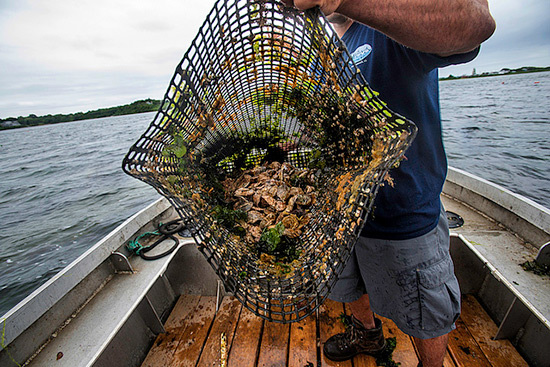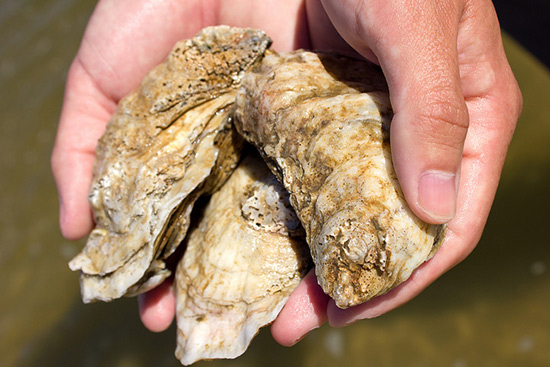Oyster aquaculture could combat Potomac River pollution
Shellfish raised on the river bottom would remove excess nutrients from the water.
Raising oysters along the bed of the Potomac River could lower pollution and improve water quality, according to new findings that show “farm-raised” shellfish are a promising method of managing nutrients.

Image courtesy Robert Rheault/Flickr
Nutrient pollution from urban, suburban and agricultural runoff has long plagued the Potomac, whose watershed spans four states and the District of Columbia and has the highest population in the Chesapeake Bay region. Excess nutrients like nitrogen and phosphorous can fuel the growth of algae blooms, which block sunlight from reaching underwater grasses and create low-oxygen dead zones that suffocate marine life. While filter-feeding oysters were once plentiful in the river—capable of removing nutrients from the water—their numbers have dropped due to overfishing and disease.
In a report published in Aquatic Geochemistry, scientists with the National Oceanic and Atmospheric Administration (NOAA) and the U.S. Geological Survey (USGS) show that cultivating shellfish on 40 percent of the Potomac’s bottom would remove all of the nitrogen now polluting the river. While conflicting uses—think shipping lanes, buried cables and pushback from boaters and landowners—mean it is unlikely that such a large area would be devoted to aquaculture, putting even 15 to 20 percent of the riverbed under cultivation would remove almost half of the incoming nitrogen. The combination of aquaculture and restored reefs could provide even greater benefits.

Image courtesy Virginia Sea Grant/Flickr
Shellfish aquaculture could also have benefits outside the realm of water quality: the shellfish could serve as a marketable seafood product, while the practice could provide growers with additional income if accepted in a nutrient trading program. Even so, the report notes that aquaculture should be considered “a complement—not a substitute” for land-based pollution-reducing measures.
“The most expedient way to reduce eutrophication in the Potomac River estuary would be to continue reducing land-based nutrients complemented by a combination of aquaculture and restored oyster reefs,” said scientist and lead study author Suzanne Bricker in a media release. “The resulting combination could provide significant removal of nutrients… and offer innovative solutions to long-term persistent water quality problems.”
At present, there are no aquaculture leases in the Potomac’s main stem. But in 2008, Maryland passed a plan to expand aquaculture in the region, and in 2009, NOAA launched an initiative to promote aquaculture in coastal waters across the United States.

Comments
Oysters can't make any difference in Potomac River water quality. A 1946 paper states “...in the late 1800’s it [the oyster harvest] averaged approximately 1,600,000 bushels." Given 300 market-sized oysters per bushel, for a few years, 480 million oysters were harvested annually. Then the harvest crashed and in recent years it has rarely exceeded 5,000 bushels.
One million market-sized oysters contain at most 150 kilograms of nitrogen (N), with sub-equal amounts in the shell and dry tissue. Even if we could harvest 480 million oysters again, only 72,000 kg of N would be removed (150 kg N / million oysters * 480 million oysters). Today, the Potomac River receives about 30 million kilograms of N each year. So the maximum oyster harvest ever recorded, which can never be reached again, could only remove 0.2% of today’s N load (72,000 / 30,000,000).
Pollution always needs to be reduced at the source and “sop-up” strategies (oysters in this case) are never effective. In the case of the Bay, the only strategy that will significantly improve water quality is to raise the fertilization efficiency of crops from around 65% where it is today to at least 80% by banning the cheap disposal of animal waste (poultry litter, sludge and manure) by land application and replacing conventional fertilizers with controlled- (slow-, timed-) release products. All the money we have spent reducing pollution from wastewater treatment plants hasn't made any significant difference in Bay water quality and more oysters won't either.
Dr. Lynton S. Land, Ophelia VA
www.VaBayBlues.org
Great article - really tells a great story!
Thank you!
Your comment has been received. Before it can be published, the comment will be reviewed by our team to ensure it adheres with our rules of engagement.
Back to recent stories